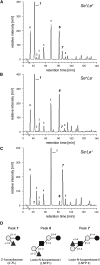Human milk oligosaccharide concentration and risk of postnatal transmission of HIV through breastfeeding
- PMID: 22894939
- PMCID: PMC3441110
- DOI: 10.3945/ajcn.112.039503
Human milk oligosaccharide concentration and risk of postnatal transmission of HIV through breastfeeding
Abstract
Background: The inefficiency of HIV breast-milk transmission may be caused by the presence of immunologically active factors, including human milk oligosaccharides (HMOs).
Objective: We investigated whether HMO concentrations are associated with a reduced risk of postnatal HIV transmission.
Design: A nested case-control study was conducted within a larger cohort study of HIV-infected women and their infants followed from birth to 24 mo in Lusaka, Zambia. Breast-milk samples collected at 1 mo from 81 HIV-infected women who transmitted via breastfeeding, a random sample of 86 HIV-infected women who did not transmit despite breastfeeding, and 36 uninfected breastfeeding women were selected. Total and specific HMO concentrations were measured by HPLC and compared between groups with adjustment for confounders by using logistic regression.
Results: HIV-infected women with total HMOs above the median (1.87 g/L) were less likely to transmit via breastfeeding (OR: 0.45; 95% CI: 0.21, 0.97; P = 0.04) after adjustment for CD4 count and breast-milk HIV RNA concentrations; a trend toward higher concentrations of lacto-N-neotetraose being associated with reduced transmission (OR: 0.49; 95% CI: 0.23, 1.04; P = 0.06) was also observed. The proportion of 3'-sialyllactose (3'-SL) per total HMOs was higher among transmitting than among nontransmitting women (P = 0.003) and correlated with higher plasma and breast-milk HIV RNA and lower CD4 counts. Neither Secretor nor Lewis status distinguished between transmitting and nontransmitting women.
Conclusions: Higher concentrations of non-3'-SL HMOs were associated with protection against postnatal HIV transmission independent of other known risk factors. Further study of these novel, potentially anti-HIV components of breast milk is warranted.
Trial registration: ClinicalTrials.gov NCT00310726.
Figures



Similar articles
-
Oligosaccharide composition of breast milk influences survival of uninfected children born to HIV-infected mothers in Lusaka, Zambia.J Nutr. 2015 Jan;145(1):66-72. doi: 10.3945/jn.114.199794. Epub 2014 Nov 19. J Nutr. 2015. PMID: 25527660 Free PMC article.
-
Human Milk Oligosaccharides Are Associated with Lactation Stage and Lewis Phenotype in a Chinese Population.Nutrients. 2023 Mar 15;15(6):1408. doi: 10.3390/nu15061408. Nutrients. 2023. PMID: 36986137 Free PMC article.
-
Longitudinal change of selected human milk oligosaccharides and association to infants' growth, an observatory, single center, longitudinal cohort study.PLoS One. 2017 Feb 9;12(2):e0171814. doi: 10.1371/journal.pone.0171814. eCollection 2017. PLoS One. 2017. PMID: 28182762 Free PMC article.
-
The Mean of Milk: A Review of Human Milk Oligosaccharide Concentrations throughout Lactation.Nutrients. 2021 Aug 9;13(8):2737. doi: 10.3390/nu13082737. Nutrients. 2021. PMID: 34444897 Free PMC article. Review.
-
Changes in HMO Concentrations throughout Lactation: Influencing Factors, Health Effects and Opportunities.Nutrients. 2021 Jun 30;13(7):2272. doi: 10.3390/nu13072272. Nutrients. 2021. PMID: 34209241 Free PMC article. Review.
Cited by
-
Tenascin-C is an innate broad-spectrum, HIV-1-neutralizing protein in breast milk.Proc Natl Acad Sci U S A. 2013 Nov 5;110(45):18220-5. doi: 10.1073/pnas.1307336110. Epub 2013 Oct 21. Proc Natl Acad Sci U S A. 2013. PMID: 24145401 Free PMC article.
-
Breastfeeding Behaviors and the Innate Immune System of Human Milk: Working Together to Protect Infants against Inflammation, HIV-1, and Other Infections.Front Immunol. 2017 Nov 29;8:1631. doi: 10.3389/fimmu.2017.01631. eCollection 2017. Front Immunol. 2017. PMID: 29238342 Free PMC article. Review.
-
Immunology of pediatric HIV infection.Immunol Rev. 2013 Jul;254(1):143-69. doi: 10.1111/imr.12074. Immunol Rev. 2013. PMID: 23772619 Free PMC article. Review.
-
Associations between human milk oligosaccharides and infant growth in a Bangladeshi mother-infant cohort.Pediatr Res. 2024 Jul;96(2):356-364. doi: 10.1038/s41390-023-02927-1. Epub 2023 Dec 5. Pediatr Res. 2024. PMID: 38052861 Free PMC article.
-
Challenges and Pitfalls in Human Milk Oligosaccharide Analysis.Nutrients. 2019 Nov 6;11(11):2684. doi: 10.3390/nu11112684. Nutrients. 2019. PMID: 31698698 Free PMC article. Review.
References
-
- Coutsoudis A, Dabis F, Fawzi W, Gaillard P, Haverkamp G, Harris DR, Jackson JB, Leroy V, Meda N, Msellati P, et al. Late postnatal transmission of HIV-1 in breast-fed children: an individual patient data meta-analysis. J Infect Dis 2004;189:2154–66 - PubMed
-
- Labbok MH, Clark D, Goldman AS. Breastfeeding: maintaining an irreplaceable immunological resource. Nat Rev Immunol 2004;4:565–72 - PubMed
-
- Kunz C, Rudloff S, Baier W, Klein N, Strobel S. Oligosaccharides in human milk: structural, functional, and metabolic aspects. Annu Rev Nutr 2000;20:699–722 - PubMed
-
- Bode L. Recent advances on structure, metabolism, and function of human milk oligosaccharides. J Nutr 2006;136:2127–30 - PubMed
-
- Bode L. Human milk oligosaccharides: prebiotics and beyond. Nutr Rev 2009;67(suppl 2):S183–91 - PubMed
Publication types
MeSH terms
Substances
Associated data
Grants and funding
LinkOut - more resources
Full Text Sources
Other Literature Sources
Medical
Research Materials

